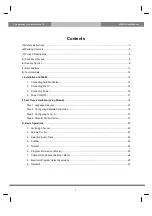
DIGITAL YACHT LTD
AIS200N2NET Quick Start Guide
Fixing location drawing
Once the unit is secured, connect the AIS/VHF antenna. Ensure the bayonet connection is fully made; should feel
a slight click as the BNC locks.
Installation Step 3
– Power
Provide power connections to the unit. Power is connected to the ten core PWR/DATA cable on the Red and
Black wires. The Red wire is the positive (+) connection. The Black wire is the negative (-) connection.
Connect the stripped wires to the nearest source of primary 12V or 24V DC power.
Ensure that the supply is
connected via the supplied 1A fuse or suitable circuit breaker.
Add the fuse in the positive power connection
to the unit if necessary.
The AIS200N2NET Receiver can be connected to other AIS compatible equipment via the NMEA0183
connections on the PWR/DATA cable, via the Male “Micro” NMEA2000 connector or via the USB interface (most
common connection for PCs). The following steps explain how to connect to each type of interface.
Installation Step 4
– NMEA 0183
The most common connection to a dedicated chart plotter is to take the NMEA Output 1 ( and Brown
–)
from the AIS200N2Net and to connect it to a free NMEA Input on the plotter. You must then tell the chart plotter
that AIS data is connected to this port and set the baud rate to 38,400 Baud
– the standard speed for AIS data.
Consult the instruction manual supplied with your Chart Plotter to understand how this is configured.
NMEA 0183 data from other equipment can be connected to either of the NMEA Inputs of the AIS200N2Net. This
is most commonly connected to NMEA Input 2 ( and Green-) at the normal 4800 baud rate for NMEA
0183. This data is then multiplexed with the AIS data and output on the NMEA Output 1 and USB at 38,400 baud
– useful when connecting to equipment that only has one NMEA input or to a computer with limited USB ports.
























